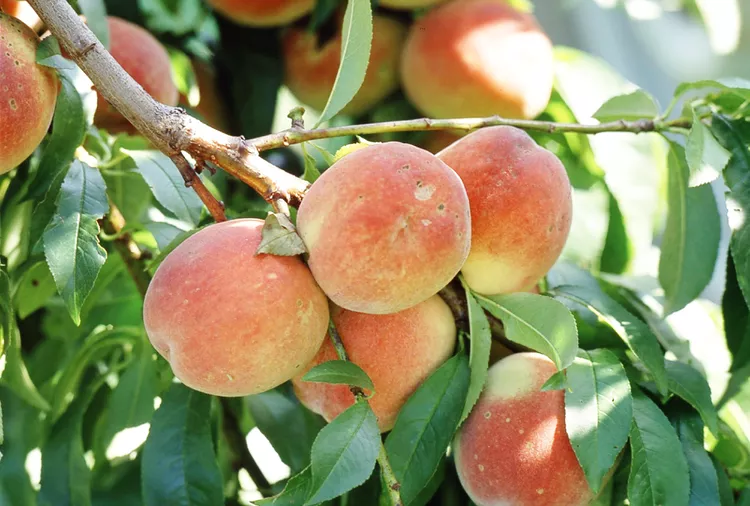Pruning peach trees at the right times can result in a treasure trove of sweet, dessert-ready fruit. Whether you're growing just a couple of trees or a whole grove of these prolific producers, knowing how to prune peach trees correctly is essential for good fruit production and ease of harvest. Plus you'll want to avoid making the wrong cuts at the wrong times, which can ruin both your harvest and your tree. Take the guesswork out of the equation with this peach tree pruning guide through the seasons.
Peach Tree Pruning Goals
- Easier harvesting. When allowed to grow with abandon, peach trees reach lofty heights, producing lots of woody growth and few fruits. Well-timed pruning can maintain your trees at 7 to 8 feet tall for convenient fruit harvest from the ground. Pruning also thins nonproductive stems, allowing light to reach the interior of the tree and ripen fruit.
- Minimizing damage. Peach trees are known to produce so much fruit that branches break under the weight of ripening peaches. Thinning fruit in early summer prevents tree damage later in the season and produces larger fruit at harvest time.
Pruning at Planting Time
A well-branched peach tree supporting developing fruit will have three or four main branches extending from the trunk. These main branches are called scaffold branches. They form the structure of the tree. The best scaffold branches connect to the trunk at about a 60 degree angle. Scaffold branches connected at an angle less than 45 degrees are weaker and won’t support a heavy fruit load.
If your newly purchased tree sapling has more than four scaffold branches, prune away the extra growth extending from the main trunk. If a scaffold branch is attached at a narrow angle, look for a nearby branch that can eventually take its place. Remove the scaffold branch with a narrow-angle attachment if a replacement is available.
Winter: Prune for Structure
Winter is a key time to prune peach trees. The leafless branches make it easier to assess the tree’s structure. Timing is important when pruning in winter. Wait to prune your trees until the threat of intense cold temperatures has passed. Trees pruned in midwinter and then exposed to extreme cold are easily damaged, and sometimes the tree dies. It is usually safe to prune peach trees about a month before the last average spring frost date in your area.
Begin winter pruning by removing all dead, damaged, or diseased branches. Then clip away any vigorous, upright shoots, which are often called watersprouts. These shoots do not produce fruit.
Next, identify the scaffold branches. Remove any shoots emerging from the main trunk that are not scaffolds. If needed, reduce the length of the scaffold branches by cutting them back to an outward-facing bud. The length of the scaffold branches determines the overall size of the tree; don’t hesitate to cut scaffolds back to create a tree that's a manageable size for harvesting.
Finally, prune shoots along each scaffold branch. Aim to have one shoot about every 12 inches along a scaffold branch. The shoots that remain after pruning will produce fruit the following summer.
Sterilize pruning tools with rubbing alcohol before you begin pruning your peach tree to avoid introducing plant diseases. Clean off the pruners again before pruning another tree.
Spring: Prune Dead or Damaged Wood
Prune peach trees minimally in spring. Peaches are produced on wood that grew last summer. Removing live wood in spring can potentially reduce fruit production. The springtime pruning goal is simply to remove dead, damaged, or diseased branches. It will be easy to see which branches were killed in winter about three weeks after leaves emerge on the trees. Remove these leafless branches to let more light into the tree's interior.
Summer: Prune to Thin Fruit
A healthy peach tree can bear such a heavy fruit load the branches break under it. And if all are left on the tree, this can vastly limit the size of all the fruit. To prevent both problems, thin the developing fruit about four weeks after the peach tree blooms.
Remove excess fruit so there is one peach about every 6 inches along a branch. Pluck the small peaches off the branch by grasping a fruit’s stem firmly near the branch and twisting it off with a quick motion. Thinning peaches can feel like an extreme process, but the fruit that remains on the tree will not only reach a larger size, but also the color and flavor will be better than fruit from a tree that is not thinned.
Tips for Peach Tree Disease Prevention
Peach trees are prone to several pests and diseases, and some of these problems get a toehold due to poor pruning practices. Use these tactics to prevent disease:
- Don’t prune during wet weather. Prune peach trees on sunny days so that pruning wounds dry quickly and disease does not have a chance to develop.
- Prune regularly. Annual pruning results in several small pruning cuts that heal over quickly, sealing off the wound from pathogens. Pruning every other year or less frequently can make for bigger cut surfaces as you remove large, overgrown branches. The larger the pruning wound, the longer it takes to heal and the greater the chance of infection.
- Don’t leave stubs. Prune branches and limbs back to the main stem. Don’t leave short branch stubs behind. The wood in branch stubs does not heal as effectively as the wood right next to a main stem.




















